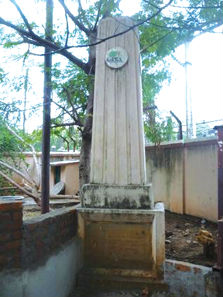Registered with the Registrar of Newspapers for India under R.N.I 53640/91
Vol. XXVII No. 13, October 16-31, 2017
Lost landmarks of Chennai
- SRIRAM V
In the gardens of temples

The Kesavaperumal Puram column
For years this was the last ‘boat stop’ if you intended to go via the Buckingham Canal to Mamallapuram. True, there was one more embarkation spot – the ‘Little Bridge Point’, but this was technically outside city limits, the river Adyar being till 1948 the outer bounds of Madras. But with the Buckingham Canal itself becoming a lost landmark of the city, so to speak, it is not surprising perhaps that a boat halt on its banks is also now forgotten.
The Serle’s Gardens stop took its name from a garden house of Madras that was on the city’s southern periphery. In today’s terms, it occupied almost all of what is the upmarket residential colony of Kesavaperumalpuram. It is in many ways appropriate that the area now takes its name from the deity Kesava Perumal, for the land had remained in the possession of one temple or the other for much of its history. From a report of Percy McQueen, ics, written for the Madras Tercentenary Volume, we know that the land on which another garden house on the Adyar, The Grange, stood, was in 1803 owned by the ‘Kadari and Kumeswara Temples’ and spanned a mammoth 46 cawnies and 9 grounds (approximately 61 acres). The Grange is now Kanchi and survives more or less as it was, hemmed by several other constructions. It is nearly opposite the old Serle’s Gardens, the Greenway’s Road dividing the two.
Not much is known of the two temples referred to above, but the trustee who administered them was Alanda Narayanaswami Naik, which probably accounts for why much of the neighbouring Raja Annamalaipuram area is also referred to as Narayanaswami Thottam by locals. In the early 19th Century, he owned almost all of the north bank of the Adyar. But by 1821, disastrous investments in pearl fishing in the Gulf of Mannar made him insolvent and all of his lands were auctioned by the Sheriff of Madras. Europeans began investing in this area and that was when Edward Greenway of the East India Company came to acquire what would later become Serle’s Gardens. When we say acquire, we should probably mean lease, for the land was categorised as maniam, which meant it was owned by a temple, in this case the Kesavaperumal Temple of Mylapore. Much of the land on the opposite side of Greenway’s Road, abutting The Grange, was, and continues to remain, the property of the Kapaliswarar Temple.
These were all garden properties of the deities, where the processional icons of the respective temples would be brought once a year for the quaint ritual of vanabhojanam. A predominantly Andhra practice, this involved taking the deity on a day-long picnic to a garden outside the town/village, offering worship there and bringing Him back at night in procession. Names such as Kapali Vanabhojana Thottam and Velleeswaran Thottam abound in the RA Puram area. Now these are all slums.
Reverting to Serle’s Gardens, it was sold by Greenway to J Olliver, Judge of the Sudder Court, in 1826. In the 1840s, the place acquired its name, owing to its being the residence of William Ambrose Serle, Prothonotary and Registrar of the Supreme Court of Madras. Thereafter, the history of the place is obscure until 1873 when we see an advertisement in The Madras Mail that the place was available for rent or outright sale. In the 1890s, Rajah Sir Savalai Ramaswami Mudaliar, the dubash of Dymes & Co and who became Sheriff of Madras in 1886, took on the lease of Serle’s Gardens. His family remained in possession of the place till the 1950s when litigation began with the temple wanting to take over. The latter eventually won.
In 1962, the land was acquired by the Kesavaperumalpuram Housing Colony, this time in outright sale from the temple. The foundation stone was laid by N.N.S. Manradiar, Minister for Co-Operation, Government of Madras, on July 7, 1962. Serle’s Gardens, the original house, must have been demolished for the construction that followed. It most likely stood where a large electricity substation has now come up.


I I have seen films in safire. Emerald and blue diamond. There was a restaurant named Nine Gems there. Please tell something about it also.